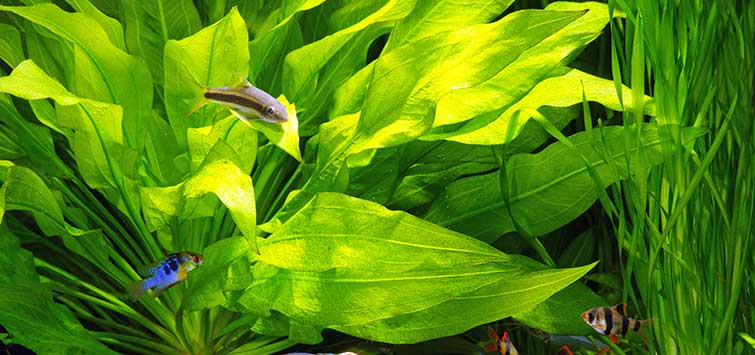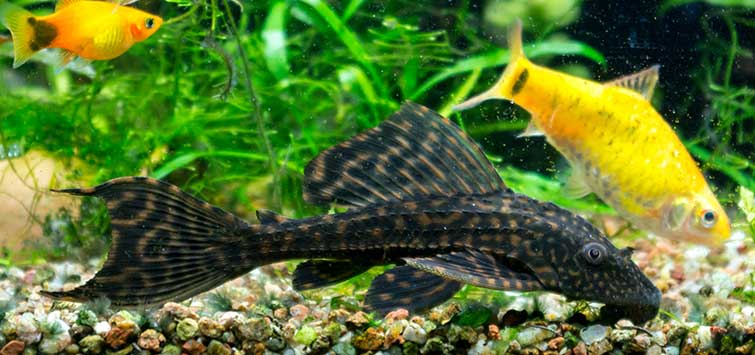The Planted Tank: Easy Rosettes
Author: Rhonda Wilson
Rosette plants grow their leaves from a central short stem, similar in appearance to a rose blossom. There are a number of rosette plants available for the aquarium, and some of them are very easy to grow in a simple setup and can produce dramatic results with a higher-tech approach.
SWORDPLANTS
Swordplants are the most commonly seen of the easy rosettes. The genus Echinodorus is found naturally in southern North America, Central America, and South America. The plants have been in cultivation for the aquarium trade for a long time, and there are many species and varieties available.
The Amazon swordplant has been a longtime favorite. Usually the plants sold as Amazon swords are actually E. bleheri. There is also an E. amazonicus (and to make things more confusing it’s also been called E. brevipedicellatus), which is much less often available in the hobby. Regardless of which of these plants you actually have, they can both grow to be very large. In time, many of the swords can take over smaller home aquariums.
In the 1970s and 80s Amazon swords, and occasionally pygmy chain swords, were about the only ones you could find for sale in the pet shops. In the 1990s more swords became available, and it seemed a lot of varieties of melon swords came out during that time. Now quite a few more species and varieties of swords have become commonly available. You can often find them with the potted aquarium plants in your local aquarium stores.
Some of the most exciting features of the swords are the incredible colors and leaf shapes that are available. They can have red, spotted, or even golden color. Leaves can be long and narrow, round, or even grass-like. The ozelot sword is a beautiful cultivar that has large light-green leaves with striking red spotting and pink blush. It will grow well in most aquariums, but it can look incredible with a good substrate and additional CO2.
E. uruguayensis is another sword I’ve really enjoyed over the years. There are several different swords once considered different species that are all now included as E. uruguayensis. I have several of these plants and have found all of them to be easy to grow, similar to the Amazon swords but somewhat smaller.
Remember when planting these medium-to-large swords that they will in fact get large, and not only will the leaves block light from any plants under them, but the roots will also cover large areas under your substrate. Moving or removing these plants after they’ve sent roots across your entire tank can be very difficult without an entire breakdown of the tank.
Even though most swords are medium to large in size, the genus does include the very popular and easy-to-grow carpeting plant, the pygmy chain sword E. tenellus. This is one of my favorite easy carpeting plants, and it is one of the few that can almost always be used successfully in a low-tech planted tank. It makes a nice low grass-like carpet across your tank. There are also narrow-leaf, broad-leaf, and red varieties of pygmy chain sword sometimes available.
CRYPTOCORYNE
Unlike the swordplants that are often used as solitary plants in the aquarium, the cryptocorynes are usually planted in groups. These popular aquarium plants are found naturally through South and Southeast Asia and New Guinea.
Many of the cryptocorynes offered for the aquarium are very similar in appearance. Add that to their very variable leaf forms, and the fact that there are several varieties within some species, and it can become incredibly difficult to correctly identify which Cryptocoryne you have. For many, you might even have to call on an expert to identify them after they have bloomed. But even the experts have difficulty deciding which plants belong to which species of crypts; the names are revised regularly, and these revisions are most likely not finished.
Fortunately, the difficulty in their exact identification doesn’t affect their beauty and utility in a planted aquarium layout. Most of the cryptocorynes you find for sale will be of a nice medium height, making them a great transitional plant to go between the tall stemmed plants in back of your tank and your low ground-cover plantings in front.
One of the medium-sized crypts found frequently is the wendtii. This plant comes in green, bronze, and red tints. It’s incredibly easy to grow in most conditions. In lower light levels the growth will be slow, but with the addition of more lighting and some supplemental CO2 , they will grow quite quickly. Even with their slower growth in simpler tanks these crypts can slowly take over. Huge mats of crypts can grow in your tanks. I’ve taken down aquariums where I’ve tried to pull out the crypts and ended up just pulling the whole substrate from the tanks in one full piece due to the extreme matting of the Cryptocoryne roots.
The smallest Cryptocoryne is C. parva. It’s not too commonly found and usually grows with very tiny, bright-green leaves. When I first got this plant I got it growing fairly well, and after quite a few new plants developed I decided to try it in several other tanks, where it either had the same small growth or did poorly—in all but one aquarium, that is. For some reason in one of my tanks it grows much larger. At first I thought I may have inadvertently put the wrong crypt in, so I have removed plants in that tank to other tanks and put more of the small-growth C.parva in. But the same small leaves develop in those plants I move from this tank to other tanks, and the large leaves develop in those I add from other tanks to this one. It was suggested this growth was due to low light, but the lighting in this tank is actually higher than most of the other tanks I’m growing it in, so in this instance that doesn’t seem to be the case.
ANUBIAS
Anubias is a beautiful genus of plants from Africa, named after the ancient Egyptian jackal-headed god of the dead. You could debate whether or not they are actually rosettes, but whatever you call them, Anubias are very interesting-looking. They don’t really look like most aquatic plants, and they grow naturally with just their roots in the water. Anubias look more like they should be growing up trees in a jungle. This makes them wonderful contrasting plants in the aquarium.
Anubias grow along a rhizome that is best grown on a piece of aquarium wood or rock. Do not plant the rhizome in the substrate. You can let the roots get into the substrate, but planting the rhizome will make it rot and die (your leaves will float up to the top of the tank and that will be the end of the plant). To grow the Anubias on wood (or rock), it’s usually best to tie the plant onto the wood and let future growth anchor it naturally. You don’t have to grow your Anubias on wood or rock; it can also be grown with the root tips in the substrate and the rhizome an inch or so above.
Anubias can be easily propagated by cuttings—just clip a section of at least a few leaves off of the rhizome. You can use a sharp knife, scissors, or sometimes your fingernails to cut the rhizome. Be careful to not squish the rhizome while you’re cutting it, as this will cause damage and kill that part of the plant.
A large Anubias, like the commonly found A. barteri, looks wonderful as a long runner on a piece of wood; they can also be dramatic plantings in large groups. There are several varieties of A. barteri, with the smaller A. barteri var. “nana” being particularly beautiful when planted in large groups. To achieve this look, the rhizomes of the plants are often lightly scored with a sharp knife to promote more leaf growth.
COLORFUL AND EASY
The rosette plants available for the aquarium come in a huge variety of sizes, leaf shapes, and colors. Many are very easy to grow, so they can be used in setups that wouldn’t support other plants. Rosettes can also be used in high-tech tanks to produce dramatic results that wouldn’t be possible in a simpler setup. All of these things make them useful plants for any aquatic gardener.R

.png?h=595&iar=0&w=2781&hash=5FD5E69473BCC22199FBFA2FB71B6033)



